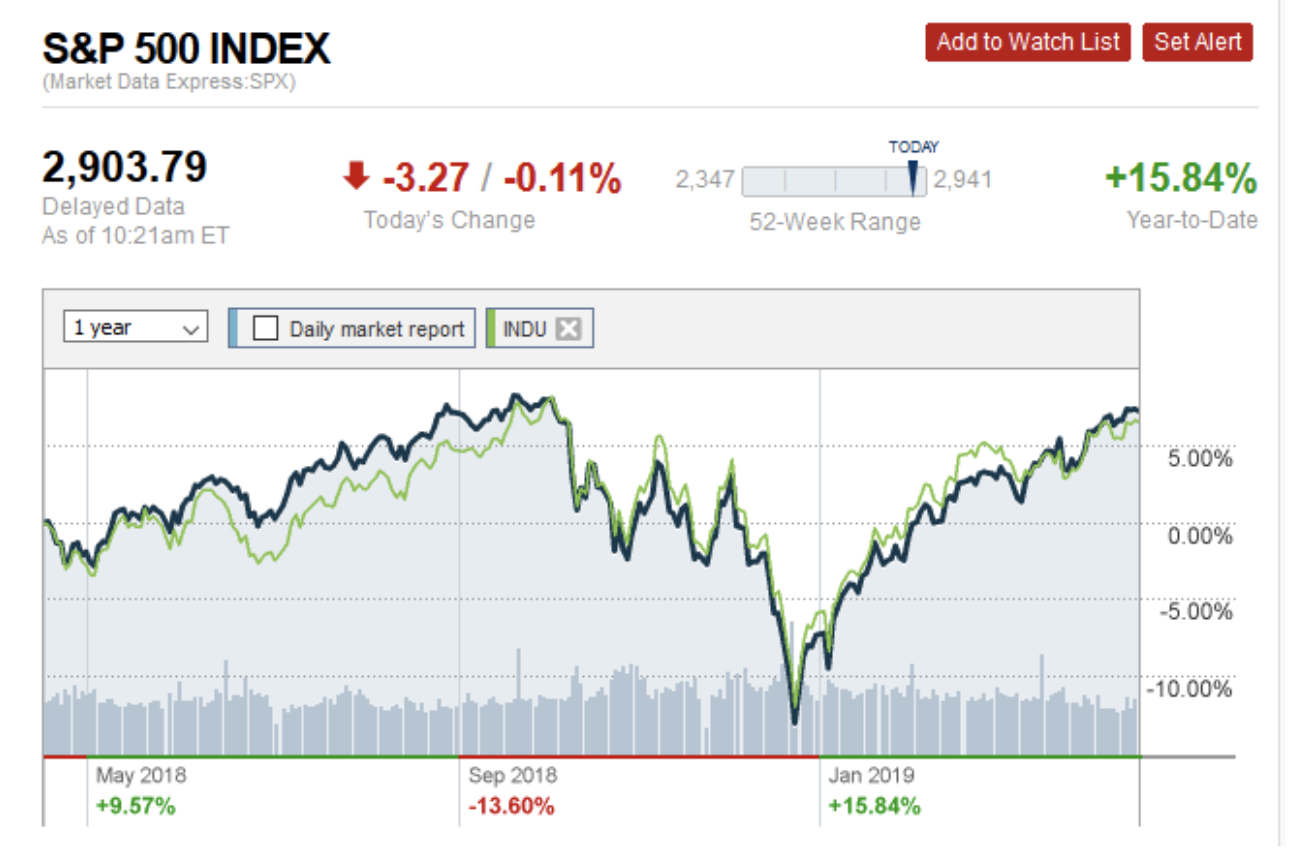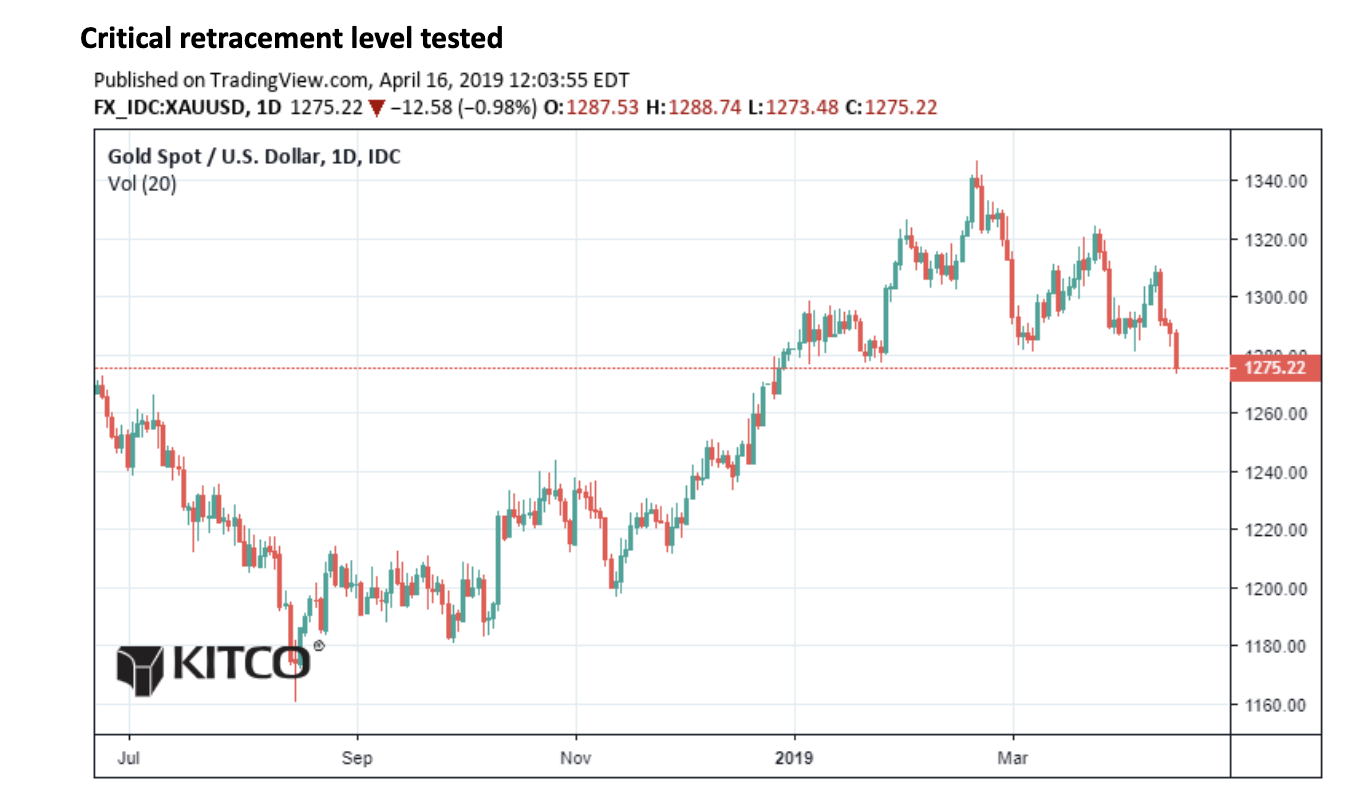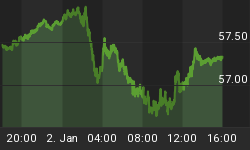Gold has once again been wrong-footed, having lost some of its luster to drop to its lowest level this year. June gold futures on Comex, GCM9, fell $11.10 on Tuesday’s session to settle at $1,277.20 an ounce, the lowest finish for the contract since December 26. The selloff came against a backdrop of equities toying with record highs and bond yields climbing, thus signaling a risk-on sentiment.
The Fed’s more accommodative monetary policy has been supportive of stock buying.
Meanwhile, bond yields have been climbing again, with the 10-Year Treasury note yielding 2.95 percent on Tuesday’s dealings thanks to solid corporate earnings that have helped bolster risk appetite. Climbing yields tend to undermine demand for non-interest paying assets like gold.
While neither condition on its own automatically leads to depressed gold prices, both working in tandem can create a formidable hurdle for the yellow metal hence the ongoing malaise.
S&P 500 vs. Dow Jones 12-Month Returns

(Click to enlarge)
Source: CNN Money
Private investors vs. central banks
Gold bulls will nonetheless feel encouraged by the fact that private investors don’t appear willing to let the bears carry the day. BullionVault data shows that 24 hours trading volume jumped 185 percent from the 12-month average with demand outweighing sales 4:1 to hit $3.7 million.
Related: Inside China’s Renewed War To Purge the Internet
This provides clear proof that private investors have been buying the dip, possibly viewing it as a hedge against geopolitical risks including Brexit as well as US-China tariff negotiations. Brexit has turned to a ticking time bomb, with the real impact of a no-deal scenario now beginning to appear worse than previously thought.
The Fraser of Allander Institute has modeled several possible Brexit outcomes and their potential impact on Britain’s economy as well as the region. Not surprisingly, the worst case scenario is a no-deal Brexit which the firm sees as leading to an economic downturn for the country in the current year to the tune of -2.1 percent. The Scottish economy could fare worse than most, with the economy contracting 5.5 percent during the second half of the year.
Meanwhile, China’s rebounding economy is thought to likely give it a stronger position during the ongoing negotiations with the US. China’s GDP expanded 6.4 percent during the first quarter while factory output jumped 8.5 percent thus exceeding earlier projections. The upturn must have irked US officials, who, including President Trump, spent much of last year crowing that China’s economic slowdown was making Beijing desperate for a deal.
Unfortunately, bold private investors still have to contend with actions by banks. Gold volumes by private traders on Tuesday were a drop in the bucket compared to Venezuela’s $400 million gold sales on Monday. The sale, which amounts to around 9 tons of gold, came weeks after Citigroup settled a gold swap transaction by selling $1.1-billion worth of gold deposits by President Maduro’s government after the latter failed to honor the debt.
Critical retracement level tested

(Click to enlarge)
Source: Kitco
Gold has undeniably lost some of its near-term luster and the bulls will be desperately searching for the next major catalyst to drive the next big leg up.
Related: America’s Biggest And Most Profitable Actually Got Tax Rebates
Admittedly, the near-term outlook doesn’t look too good. Short-term indicators point to lower prices with the current price of $1,276.60 dangerously close to breaching the 38.2 percent Fibonacci retracement level around $1,275. The ongoing risk-on environment is hardly conducive for investors to hold the metal and buying momentum has been waning. Whereas weakness by the US economy remains a major risk factor, it’s still strong enough and factors such as strong corporate earnings will likely continue to keep a lid on prices as long as they persist.
Yet, the bulls might eventually have their wish according to one Wall Street punter. Despite the latest slip, Credit Suisse says it remains upbeat about gold prices due to what it terms as ‘‘favorable macro factors’’ including geopolitical issues. Moreover, it’s still too early to assume the global economy has returned to full health, meaning investors are not likely to rush to dump their holdings. The banker estimates an average gold price of ~US$1,280/oz in 2019.
For investors looking to buy at a bottom, keep an eye on $1,264 as the next critical support level.
By Alex Kimani for Safehaven.com

















